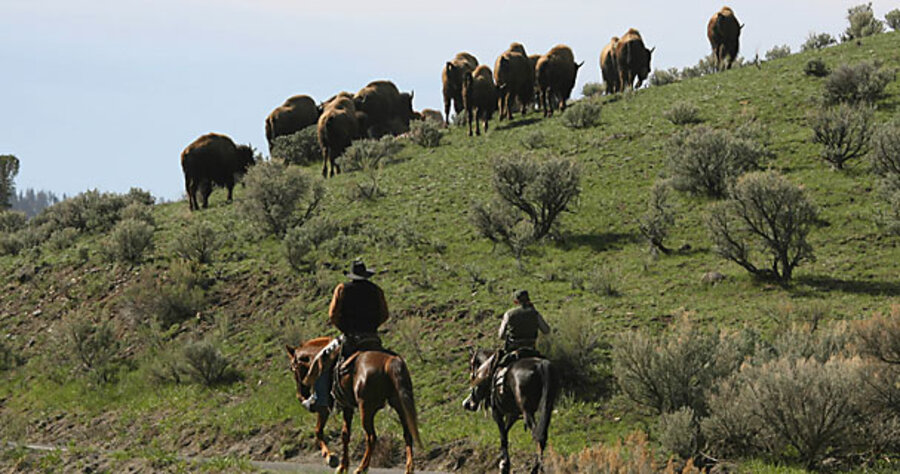In Montana, bison plan paused
Loading...
| Gardiner, Mont.
On a knoll rising above this quaint Yellowstone gateway town, a pregnant bison, only weeks from giving birth to her calf, straddles an invisible boundary and feasts tranquilly upon a profusion of spring grass.
Although it’s early in the tourist season for America’s first national park, a carload of visitors halts and eagerly snaps photos of the great American wildlife icon.
In their exuberance, few onlookers seem to realize that the woolly beast is actually a survivor. More than half the park’s herd of 4,700 buffalo have perished over the last six months – the largest kill-off since the 19th century.
Some were hunted; others didn’t survive a bad winter. But most were captured and trucked to slaughter under a controversial plan aimed at preventing them from mingling with beef cattle once they wander beyond the park’s fenceless border into Montana.
Now the high death toll is prompting public outrage. Montana Gov. Brian Schweitzer and park officials abruptly suspended the killing two weeks ago. The governor says a compromise on the issue – a political quagmire that reaches back decades – is in the offing, one that would give the bison more room to wander. The cattle industry, however, vows to fight.
“What we’re witnessing are the battle lines of bison conservation in the New West,” says Tim Reid, Yellowstone’s deputy chief ranger. “It’s very contentious and very complicated. No victories for bison are ever easily won.”
The controversy stems from brucellosis, a disease that Yellowstone bison can carry and which affects fertility in domestic female cattle. If spread, it could jeopardize the Western ranchers’ ability to ship their animals to market.
The Yellowstone bison population is world-renowned, says Michael Scott, executive director of the Greater Yellowstone Coalition, a conservation group. Not only are they direct descendants of the last wild buffalo herds that once populated the Great Plains, they are much beloved by the public and are the emblem for the US Interior Department.
Conservationists complain that even when no beef cattle have been near Yellowstone and the risk of disease transmission was very low, Montana under two Republican governors resorted to bison slayings as a primary management option.
Governor Schweitzer, a Democrat and the first cattleman-turned-Montana governor since 1915, shares the beef industry’s worries about disease, but he also has a soft spot for buffalo. “I favor a commonsense solution and frankly it’s common sense that has been lacking,” he says in an interview.
Schweitzer calls a bison management plan struck between the state and federal government seven years ago “a bad document.” His conclusion is partly shared by auditors for the Government Accountability Office, who said that while the plan aimed to balance cattle protection and wildlife conservation, it has overwhelmingly favored bison killing. The governor’s main focus has been to give bison more space outside Yellowstone’s northern and western perimeter by halting cattle grazing near the park.
Schweitzer says “a historic agreement” was reached in April when the federal government purchased a 30-year conservation easement, costing several millions dollars, from a rancher near Gardiner, clearing the way for safer bison passage along the Yellowstone River.
The Montana Stockgrowers Association opposes the governor’s plan because it could jeopardize their ability to export beef, says spokesman Jay Bodner. Ranchers instead want to eradicate the disease by using vaccines and killing all bison that test positive for the disease. However, because brucellosis is found in dozens of wildlife species, current methods can’t eliminate it completely without depopulating Yellowstone of its wildlife, experts say.
There are no modern documented cases of Yellowstone bison infecting Montana cattle. In neighboring Idaho and Wyoming, some cases have been linked to elk.
Typically, when bison wander out, helicopters, cowboys on horseback, and ATVs push them back into the park but often without much success. Recent mild winters have enabled more bison to survive than normal, causing huge numbers to leave the park. The dramatic drop in bison numbers this year will probably mean fewer animals leaving the park next winter.
Although Yellowstone’s bison are in no real danger of extinction, the loss of animals will affect the visual abundance that visitors normally encounter during the summer.
“It’s been a horrible, horrible year for bison,” says barb abramo, an activist (who does not capitalize her name) with the Buffalo Field Campaign that has protested the bison slaughter.
During a recent 30-mile drive to Old Faithful Geyser from her hometown of West Yellowstone, Mont., Ms. abramo says she recorded the fewest bison sightings in 14 years. “Every spring, we would usually see groups of between 200 and 400 animals at various locations,” she said. “The most we saw were 41 adults and four calves.”
Later this year, 25 bison fitted with radio collars will be allowed to venture farther from Yellowstone than any previous bison generation. Paradoxically, as they move, they’ll be more closely monitored – and killed, if they come too near cattle herds.
“There is room for cautious optimism that things will be better,” says Mr. Reid, the Yellowstone ranger. “But there is no silver bullet for stopping the conflict.”





